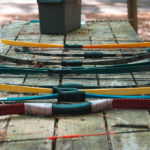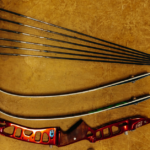When I first picked up a compound bow, I felt completely overwhelmed. The technical jargon, intricate adjustments, and array of accessories made my head spin. It seemed like I needed an engineering degree just to understand what I was holding! But don’t worry – I’ve done the hard work for you.
This guide will break down everything you need to know to choose the perfect compound bow as a beginner.
Key Factors for Beginner-Friendly Compound Bows
Three main elements decide how comfortable and effective a compound bow will be for new archers:
- Draw weight
- Draw length
- Overall adjustability
Let’s take a look at each of these crucial factors:
Draw Weight
Draw weight refers to the force required to pull the bowstring back to full draw. For beginners, it’s essential to start with a lower draw weight, typically between 10-30 pounds.
This allows you to focus on developing proper form and technique without straining your muscles or risking injury.
Many beginner-friendly compound bows offer adjustable draw weights. This fantastic feature allows you to increase the weight as you build strength and skill over time.
Starting low and gradually working your way up is the key to long-term success and enjoyment in archery.
Draw Length
Draw length is the distance from the nocking point on the string to the pivot point of the grip, plus 1.75 inches, when the bow is at full draw. This measurement is crucial for both accuracy and comfort.
A bow with an adjustable draw length is ideal for beginners, as it allows for fine-tuning as you develop your shooting form.
Most adult beginners will find their draw length falls between 26-29 inches. However, it’s always best to have this measured professionally at an archery shop.
They can help you decide your exact draw length and set up your bow accordingly.
Adjustability
Adjustability is the secret sauce for beginners because it allows the bow to grow with you as your skills improve. Look for bows that offer a wide range of adjustments in both draw weight and draw length.
This flexibility means you won’t outgrow your first bow too quickly, saving you money in the long run and allowing you to focus on skill development rather than constantly upgrading equipment.
Top Compound Bow Options for Beginners
Now that we understand the key factors, let’s explore some of the best compound bow options for those just starting out:
1. Bear Cruzer G2
The Bear Cruzer G2 is a standout choice for beginners because of it’s incredible versatility. Here’s why it’s such a popular option:
- Draw weight range: 5-70 pounds
- Draw length range: 12-30 inches
- Ready-to-hunt package includes essential accessories
The Cruzer G2’s wide adjustment ranges make it suitable for archers of all sizes and skill levels, from young beginners to adults. This means you can start with a comfortable, low draw weight and gradually increase it as you build strength and confidence.
The included accessories (sight, arrow rest, and quiver) provide excellent value for beginners who might otherwise feel overwhelmed by choosing individual components. This all-in-one package gets you shooting quickly and accurately right out of the box.
2. Diamond Infinite Edge Pro
The Diamond Infinite Edge Pro is another highly adjustable option that caters well to beginners:
- Draw weight range: 5-70 pounds
- Draw length range: 13-31 inches
- Exceptionally smooth draw cycle
What sets the Infinite Edge Pro apart is it’s remarkably smooth draw cycle. This feature makes it comfortable for beginners to shoot for extended periods without fatigue, allowing for longer practice sessions and faster skill development.
The bow’s compact design also makes it highly maneuverable in tight spaces. This versatility is great for both target practice in your backyard and potential hunting scenarios down the line.
3. PSE Stinger Max
For budget-conscious beginners, the PSE Stinger Max offers excellent value without compromising on quality or performance:
- Draw weight range: 22-55 pounds
- Draw length range: 21.5-30 inches
- Smooth shooting experience
- Affordable price point
The Stinger Max provides plenty of room for growth with it’s adjustable settings. It’s smooth shooting experience helps beginners develop consistent form, which is crucial for long-term success in archery.
While it may not have quite as wide an adjustment range as the previous two options, the Stinger Max still offers more than enough flexibility for most beginners to start with and grow into over time.
Essential Accessories for Beginner Archers
Choosing the right bow is only part of the equation. To get the most out of your new compound bow, you’ll need some essential accessories:
Arrow Rest
An arrow rest supports your arrow and helps guide it during the shot. For beginners, I highly recommend a simple whisker biscuit rest.
Here’s why:
- Easy to use
- Forgiving of small form errors
- Keeps the arrow securely in place
As you advance in skill, you may want to explore other types of rests, but a whisker biscuit is an excellent starting point for new archers.
Bow Sight
A bow sight helps you aim more accurately by providing a reference point to align with your target. For beginners, I suggest a multi-pin sight:
- Allows for shooting at various distances
- Typically includes 3-5 pins for different yardages
- Adjustable for windage and elevation
Start by setting your pins for common shooting distances (e.g., 10, 20, and 30 yards) and adjust as needed based on your typical shooting scenarios.
Release Aid
While not strictly necessary, a release aid can significantly benefit beginners:
- Helps achieve a cleaner release
- Improves accuracy
- Reduces string pinch on fingers
A simple wrist-strap release is a good starting point for most new archers. As you progress, you may want to explore different types of releases to find what works best for your shooting style.
Stabilizer
A stabilizer serves two primary purposes:
- Reduces bow vibration after the shot
- Improves overall stability and balance
For beginners, a short (6-8 inch) stabilizer is usually enough. As you advance, you may want to experiment with longer stabilizers or multi-rod setups for even greater stability.
Arrows
Selecting the right arrows is crucial for both performance and safety. Ensure you choose arrows that are properly spined (stiffness) for your bow’s draw weight and your draw length.
Factors to consider include:
- Arrow material (carbon, aluminum, or hybrid)
- Arrow length
- Arrow spine (stiffness)
- Fletching type and configuration
I recommend consulting with a professional at an archery shop to help you choose the best arrows for your specific setup and shooting style.
Common Pitfalls for Beginner Archers (And How to Avoid Them)
As a new archer, it’s easy to fall into some common traps. Here are some mistakes to watch out for:
1. Choosing Too High a Draw Weight
Many beginners are tempted to start with a high draw weight, thinking it will make them more powerful or accurate. This approach often backfires, leading to:
- Poor form and technique
- Muscle fatigue and strain
- Discouragement and frustration
Solution: Start with a lower draw weight that allows you to focus on proper form. You can always increase the weight as you build strength and skill over time.
2. Neglecting Proper Bow Fitting and Basic Training
A poorly fitted bow can severely hamper your progress and enjoyment of archery. Many new archers skip this crucial step, leading to:
- Inaccurate shots
- Inconsistent form
- Potential injury
Solution: Take advantage of professional fitting services offered by many archery shops. They can help you:
- Determine your fix draw length
- Set up your bow properly
- Provide basic instruction on form and technique
This initial investment in proper fitting and training will pay dividends in your archery journey.
3. Focusing Too Much on Distance Too Soon
It’s exciting to see your arrows flying far downrange, but focusing on distance before mastering proper form can ingrain bad habits. This can lead to:
- Inconsistent shooting
- Difficulty improving accuracy
- Frustration with perceived lack of progress
Solution: Start by practicing at closer ranges (10-20 yards) to focus on form and consistency. Gradually increase your distance as your skills improve.
4. Neglecting Regular Maintenance
A well-maintained bow performs better and lasts longer. Many beginners overlook basic maintenance tasks, which can lead to:
- Decreased accuracy
- Premature wear on bow components
- Potential safety issues
Solution: Develop a regular maintenance routine that includes:
- Checking and tightening all screws and bolts
- Waxing the bowstring
- Inspecting the cables and string for wear
- Lubricating moving parts as needed
5. Rushing the Shot Process
Excitement or nervousness can cause beginners to rush their shots, leading to:
- Poor form
- Inconsistent anchor points
- Decreased accuracy
Solution: Develop a consistent pre-shot routine and focus on executing each step deliberately. This might include:
- Setting your stance
- Nocking the arrow
- Gripping the bow
- Drawing the string
- Anchoring
- Aiming
- Releasing
Take your time with each step, and don’t rush to release the arrow.
Developing Your Skills: Practice Techniques for Beginners
Consistent practice is key to improving your archery skills. Here are some effective practice techniques for beginners:
1. Focus on Form First
Before worrying about hitting the bullseye, concentrate on developing consistent, proper form. This includes:
- Stance: Feet shoulder-width apart, perpendicular to the target
- Grip: Light touch on the bow handle, avoiding a death grip
- Anchor point: Consistent placement of your drawing hand on your face
- Release: Smooth, surprise release without jerking or flinching
Spend time practicing these elements without even shooting arrows. Use a stretch band or your unloaded bow to work on your draw and anchor.
2. Short-Range Accuracy Drills
Set up a target at 10 yards and shoot 30 arrows, focusing on maintaining consistent form with each shot. Pay close attention to your anchor point, release, and follow-through.
As you become more comfortable, gradually increase the distance to challenge yourself.
3. Blank Bale Shooting
Shoot at a large, blank target from very close range (3-5 yards) without aiming. This drill helps you focus entirely on your form and shot execution without the distraction of aiming or scoring.
4. Group Tuning
Once you’re consistently hitting the target, work on tightening your groups. Don’t worry about where on the target you’re hitting – focus on getting your arrows close together.
This helps develop consistency in your form and execution.
5. Single Spot Focus
Pick a small spot on your target (like a small sticker or piece of tape) and focus on hitting just that spot. This helps develop concentration and precision in your aiming.
6. Varied Distance Practice
Set up many targets at different distances. Shoot a few arrows at each, adjusting your aim for the changing distances.
This helps develop your ability to judge distance and make quick adjustments.
7. Pressure Drills
Once you’re comfortable with basic shooting, add some pressure to your practice. Time yourself, compete with friends, or set challenging goals to simulate the pressure of competition or hunting scenarios.
Remember, quality practice is more important than quantity. It’s better to shoot 20 arrows with perfect form than 100 with sloppy technique.
Advancing Your Archery Journey
As you progress in your archery journey, you’ll find that the skills you develop with your beginner compound bow serve as a strong foundation for more advanced techniques. You’ll become more attuned to the nuances of your equipment, understanding how small adjustments can affect your shot.
Some areas you might explore as you advance include:
- Fine-tuning your bow’s cam timing and synchronization
- Experimenting with different arrow rests (e.g., drop-away rests)
- Trying out various release aids (e.g., thumb releases, hinge releases)
- Exploring different stabilizer configurations
- Learning about advanced aiming techniques like gap shooting or string walking
Remember, archery is a lifelong learning process. Even the most experienced archers continually work on refining their technique and experimenting with new equipment and methods.
Key Takeaways
- Choose a bow with adjustable draw weight and length to accommodate your growth as an archer.
- Start with a lower draw weight to focus on form and technique.
- Invest in essential accessories like an arrow rest, sight, and properly spined arrows.
- Get professionally fitted and take advantage of basic training opportunities.
- Practice consistently, focusing on form rather than power or distance initially.
- Be patient with your progress and enjoy the learning process.
- Regularly maintain your equipment to confirm optimal performance and longevity.
People Also Asked
What is the best draw weight for a beginner archer?
Most beginners should start with a draw weight between 10-30 pounds. This allows for proper form development without excessive strain.
How much does a good beginner compound bow cost?
Quality beginner compound bows typically range from $200 to $500, with some ready-to-shoot packages costing up to $700.
Can I teach myself archery, or do I need lessons?
While self-teaching is possible, taking lessons from a qualified instructor can significantly speed up your learning and help you avoid developing bad habits.
How often should I practice archery as a beginner?
Aim for 2-3 practice sessions per week, each lasting 30-60 minutes. Consistency is more important than long, infrequent sessions.
What’s the difference between a compound bow and a recurve bow?
Compound bows use a system of cables and cams to provide a mechanical advantage, making them easier to hold at full draw. Recurve bows are simpler in design and rely more on the archer’s strength.
Are compound bows good for hunting?
Yes, compound bows are excellent for hunting because of their power, accuracy, and ability to hold at full draw for extended periods.
How long does it take to become proficient with a compound bow?
With regular practice, most beginners can achieve basic proficiency in 3-6 months. However, mastery can take years of dedicated practice and experience.
What safety equipment do I need for archery?
Essential safety equipment includes an arm guard to protect your forearm from string slap and a finger tab or release aid to protect your fingers. A chest guard is also recommended, especially for recurve archers.
Can children learn to use compound bows?
Yes, many compound bows are designed specifically for youth archers with suitable draw weights and adjustable settings to accommodate growth.
How do I know if my draw length is correct?
A properly fitted draw length allows you to anchor consistently and comfortably. Your bow arm should be slightly bent, and your release hand should anchor at a consistent point on your face.
Professional fitting at an archery shop is the best way to decide your fix draw length.



